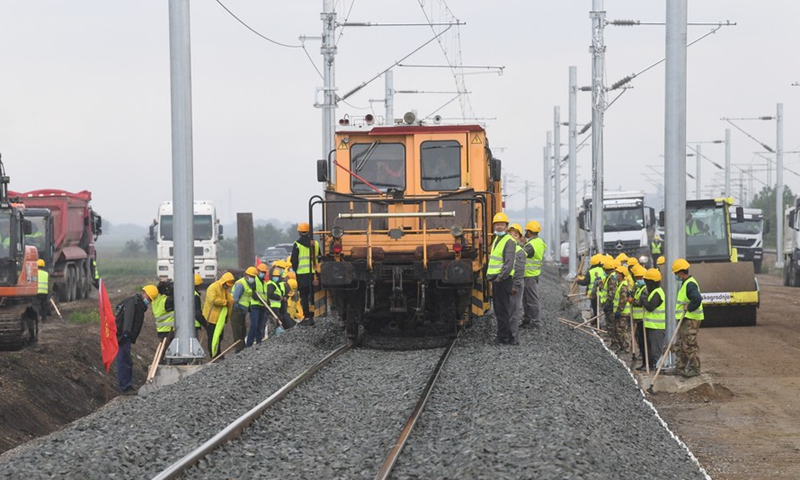
Workers are seen at the construction site of the Belgrade-Budapest railway in Stara Pazova, Serbia, May 30, 2020.Photo:Xinhua
Officials from Serbia and Hungary on Tuesday hailed the start of construction of a railway line running from Novi Sad to Subotica in Serbia, which is part of the Hungary-Serbia railroad project, as not only a significant progress in the major project under the Belt and Road Initiative (BRI) but also a step forward in cooperation with China.
The latest development also offered a resounding rebuttal to accusation and slanders from some foreign politicians and media outlets against the project, the BRI as well as broad cooperation between China and Eurasian countries, analysts noted.
The railway, which will have a total length of 108.1 kilometers, starts from Serbia's second-largest city Novi Sad and runs via Subotica to the Hungary-Serbia border. This sector includes underpasses, overpasses and other infrastructure.
Serbian President Aleksandar Vucic highlighted the importance of the railway for the development of Serbia, and praised friendly ties with both China and Hungary, at a ceremony on Monday.
"We will enjoy this, and it will bring benefits both through construction and through higher salaries and pensions, a higher standard of living, and a better future for our children," Vucic was quoted as saying in a statement released by China's State Council Information Office on Tuesday.
The Hungary-Serbia railway connects Budapest, the capital of Hungary, and Belgrade, the capital of Serbia, with a total length of 350 kilometers and a designed speed of 200 kilometers per hour.
"The 350-kilometer railroad will enable people and goods to travel between the capitals of Serbia and Hungary in around two hours," Vucic added.
Since signing a commercial contract for the project in July 2018, China has built a second line for the existing single-line electrified railroad in Serbia and sped up its transformation to a double-line passenger and freight railroad.
The Serbian part of the railway will be completed in three years, Vucic noted, while Peter Szijjarto, Hungarian Minister of Foreign Affairs and Trade, said that the Hungarian section of the railway, which is 167 kilometers long, should be finished before 2025.
Szijarto noted that Hungary and Serbia are both looking forward to cooperation with China, as they believe it will help raise their respective living standards.
The China Railway International Corp, a major partner for the project, said that the Hungary-Serbia railway is viewed as a key project in the BRI and will boost China's cooperation with Central and Eastern Europe.
"The construction of the railway will strengthen the interconnection between Hungary and Serbia, as well as expanding economic and trade cooperation and exchanges between China and the two countries," Cui Hongjian, director of the Department of European Studies at the China Institute of International Studies, told the Global Times on Tuesday.
Cui noted that the railway also represents the resilience of cooperation between China and Central and Eastern Europe despite the sporadic flare-ups of the pandemic, as well as reflects the country's sincerity to cooperate with Europe.
Global Times




